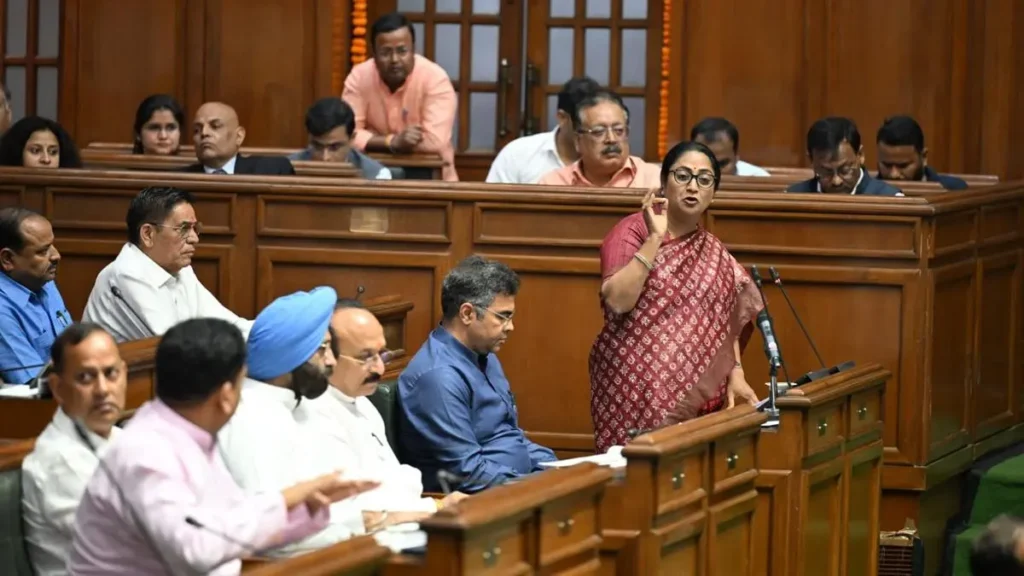At a little over two hours, Delhi Chief Minister Rekha Gupta’s maiden Budget speech in the State Assembly on March 25 was the longest-ever Budget presentation in the history of the Vidhan Sabha. Also record-breaking was the total outlay of the Budget, a whopping Rs. 1,00,000 crore—31.6 per cent higher than the previous financial year.
With the Bharatiya Janata Party (BJP) returning to power in the national capital after a gap of 26 years, the new government ensured that the Budget strongly reaffirmed the themes on which it had campaigned. The BJP rode to power on the promise of a “double engine government” that would facilitate development in Delhi, and the record outlay reflects the Centre’s financial backing.
Chants of “Modi, Modi” and the thumping of desks by ruling party members accompanied the Budget presentation, which repeatedly emphasised the “double engine government” theme. In her speech, Gupta made numerous references to Prime Minister Narendra Modi, acknowledging the significant role the Centre would have to play in fulfilling poll promises and delivering on both welfare and development fronts.
Also Read | The Budget peekaboo: What you don’t see is what you get
Describing the Budget as “historic”, Gupta, who also holds the finance portfolio, said: “This Budget is a resolution to realise the dream of a self-reliant Delhi, which is inspired by Prime Minister Shri Narendra Modi ji and his vision of a ‘Developed India’.” She later added that the “historic increase” in Budget estimates “has been possible only with the guidance of the Hon’ble Prime Minister Narendra Modi ji”.
The boost in outlay comes largely from grants and loans to be provided by the Centre. According to the Budget speech, the financing will come from tax revenue of Rs. 68,700 crore, non-tax revenue of Rs. 750 crore, small savings loans of Rs. 15,000 crore, the Central Road Fund (Rs. 1,000 crore), Centrally-sponsored schemes (Rs. 4,128 crore), and grants-in-aid from the Union government (Rs. 7,348 crore), with the remaining amount drawn from the opening balance.
Shifting gears from AAP
The Budget sought to mark a decisive break from the 10-year rule of the Aam Aadmi Party (AAP), with Gupta frequently asserting that the new government would be different from its predecessor. She attacked the previous regime for “corruption and mismanagement”.
“The days of corruption, mismanagement, and inefficiency are gone with the AAP(da) government,” she declared. “In this historic Budget of Rs. 1,00,000 crore, capital expenditure has nearly doubled. Last year, the allocation for capital expenditure was Rs. 15,089.25 crore; it is now proposed at Rs. 28,115.48 crore. This capital expenditure allocation in the ‘Viksit Delhi’ Budget is clear proof of our commitment to improving roads, drains, sewerage, and education facilities.”
Contradictions with Gupta’s statements
While Gupta underlined how her government’s Budget differed from that of its predecessor, the key allocations remain consistent with the AAP regime’s priorities, with a significant share reserved for education and health. The Budget accommodates BJP’s manifesto promises while retaining several existing welfare schemes.
The major allocations include Rs. 19,291 crore for education, Rs. 12,952 crore for transport, and Rs. 12,893 crore for health. An allocation of Rs. 5,100 crore has been made for the Mahila Samriddhi Yojana, under which Rs. 2,500 per month will be given to women from economically disadvantaged families. With water, sanitation, and Yamuna pollution emerging as major election issues, the government has earmarked Rs. 9,000 crore for these interconnected sectors.
Gupta also announced the launch of the Union government’s health insurance scheme, Ayushman Bharat, in Delhi. Her government will provide an additional Rs. 5 lakh in insurance coverage to beneficiary families, over and above the Rs. 5 lakh provided by the Centre.
Opposition parties, however, have questioned the BJP government’s claims regarding Budget allocations. They noted that, in a significant departure from tradition, the government did not present the Economic Survey, which provides key insights into the State’s economic health.
Also Read | Budget 2025: The class project in full swing
Leader of the Opposition Atishi termed the Budget “economically baseless” and “devoid of credibility”. “This so-called Rs. 1,00,000 crore Budget has no economic foundation. The moment Chief Minister Rekha Gupta presented it in the Assembly, it became clear why the BJP deliberately withheld the Economic Survey,” she said.
Atishi also pointed out that, for the first time in a decade, the education allocation was less than 20 per cent of the total Budget. She added that the allocation for health—13 per cent—was the lowest in 10 years. Delhi Congress president Devender Yadav warned that the government’s debt burden would increase due to the loans being sought to fund the Rs. 1,00,000 crore outlay. “The Government of India had objected when the previous government sought a Rs. 10,000 crore loan, citing a likely surge in Delhi’s debt. Given the State’s fiscal health, the Budget raises serious questions about the BJP government’s lofty claims and their implications for Delhi’s finances,” he said.
According to Budget papers, Delhi’s fiscal deficit for 2025-26 is pegged at Rs. 13,702.95 crore—sharply higher than the revised estimate of Rs. 1,523 crore in the previous fiscal. The revenue surplus for 2025-26 is estimated at Rs. 9,661.31 crore, up from Rs. 8,313.72 crore in 2024-25. However, revenue surplus has been declining in recent years, having dropped steeply from Rs. 14,457 crore in 2022-23 to Rs. 4,966 crore in 2023-24.
Gupta has presented an ambitious Budget. The challenge now lies in balancing her party’s electoral promises with the imperative of maintaining Delhi’s fiscal stability.
Source:https://frontline.thehindu.com/news/delhi-budget-2025-record-allocation-bjp-vs-aap-fiscal-deficit/article69377680.ece

